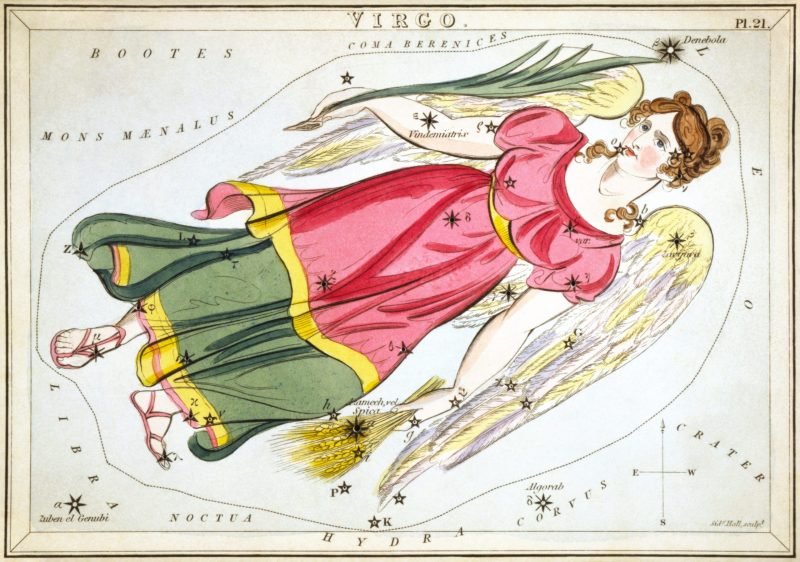
Virgo the Maiden fully returns to the east at nightfall by late April. By late May, Virgo is well up in the evening. You’ll find Virgo in the evening sky into June and July, too. Then by late August or September, Virgo begins her descent in the west into the glow of evening twilight. In other words, now is the time to watch for Virgo. How can you see her?
Virgo ranks as the largest constellation of the zodiac and the second-largest constellation overall (after Hydra). Yet Virgo is long and rambling, with no well-defined pattern. What to do? There’s a simple solution. Virgo’s 1st-magnitude star, blue-white Spica, makes this constellation easy to locate in the night sky.
Just remember this mnemonic: follow the arc to Arcturus and drive a spike to Spica. Follow the arc in the handle of the Big Dipper until you see an orange star. That is Arcturus in the constellation Boötes. Then continue that line to Spica, as shown on the chart below.
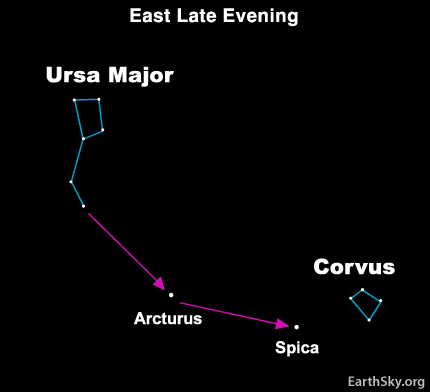
Virgo in skylore
In the sky, the constellation Virgo personifies Persephone, daughter of Demeter, the harvest goddess. According to a Greek myth, it was once springtime, always, on Earth. But then the god of the underworld, Hades, kidnapped Persephone.
Her mother Demeter was overcome with grief by the loss of her only child. So she abandoned her role as as Earth goddess, and the world’s fruitfulness and fertility suffered. In some parts of the globe, it’s said, winter cold blasted the blooming Earth. Elsewhere, summer heat scorched the Earth and gave rise to pestilence and disease.
According to the myth, Earth wouldn’t become fruitful again until Persephone returned home. Humanity might have been finished … but Zeus, the king of the gods, stepped in. Zeus insisted that the god of the underworld return Persephone to Demeter. Zeus also said that Persephone must eat nothing until her return. Alas, the god of the underworld purposely gave Persephone a pomegranate. She sucked a pomegranate seed on her way home.
Thus Persephone was given back to her mother, but Persephone – because of the pomegranate – has to return to the underworld for four months every year. To this day, spring returns to the Northern Hemisphere when Persephone is reunited with Demeter. The winter season reigns when Persephone dwells in the underworld.
From the perspective of the Northern Hemisphere, Virgo is absent from early evening sky in late autumn, winter and early spring. Virgo’s return to the sky at nightfall – in the months of April and May – coincides with the season of spring.
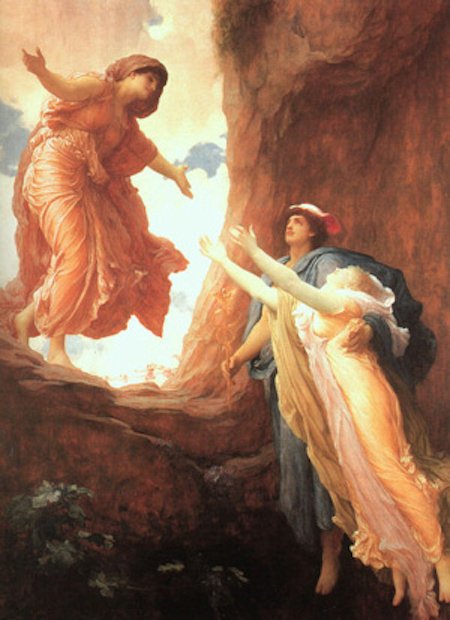
Sun in front of Virgo on your birthday?
The dates of the sun’s passage through Virgo will conflict with what you read in an astrological horoscope. A horoscope says the sun is in Virgo from about August 23 to September 22. But astrologers are referring to the sign – not the constellation – Virgo. Yes, there’s a difference between a constellation and a sign! A constellation of the zodiac refers to a section of the real starry sky. A sign of the zodiac refers to a seasonal position of the sun in an ancient system, irrespective of the true sky. In the real sky, the sun passes in front of Virgo each year from about September 16 to October 30.
Notice that the sun stays in front of Virgo for longer than a month. That’s because Virgo is such a large constellation.
By definition, the first point of (the sign) Libra always coincides with the sun’s position on the September equinox. This is in spite of the fact that, in our modern era, the sun shines in front of the constellation Virgo on the September equinox. The sun resides in the sign Libra for one month, starting on or near September 23. In the real sky, the sun shines in front of the constellation Virgo during this period of time.
Constellations are less abstract than signs. Astronomers who observe the night sky are nearly always speaking of constellations, not signs.
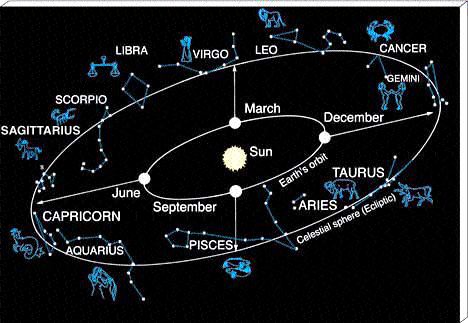
The Virgo galaxy cluster
In mythology, Virgo represents fruitfulness and fertility. And this constellation has also proven its fruitfulness to us in the modern era. Telescopes reveal Virgo as home of the great Virgo galaxy cluster, made up of thousands of galaxies.
Small telescopes show a few of these galaxies as faint smudges of light. That in itself is pretty amazing, given that the Virgo cluster of galaxies lies some 65 million light-years distant!
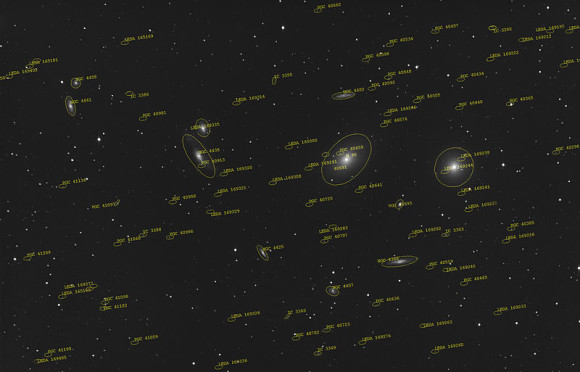

Bottom line: The constellation Virgo the Maiden fully returns to sky at nightfall – with her feet planted on the eastern horizon – by late April or early May. This post has information about how to find the constellation Virgo, its brightest star, interesting things to see within its boundaries, and its mythology.
The post Virgo? Here’s your constellation first appeared on EarthSky.
from EarthSky https://ift.tt/3uresn5

Virgo the Maiden fully returns to the east at nightfall by late April. By late May, Virgo is well up in the evening. You’ll find Virgo in the evening sky into June and July, too. Then by late August or September, Virgo begins her descent in the west into the glow of evening twilight. In other words, now is the time to watch for Virgo. How can you see her?
Virgo ranks as the largest constellation of the zodiac and the second-largest constellation overall (after Hydra). Yet Virgo is long and rambling, with no well-defined pattern. What to do? There’s a simple solution. Virgo’s 1st-magnitude star, blue-white Spica, makes this constellation easy to locate in the night sky.
Just remember this mnemonic: follow the arc to Arcturus and drive a spike to Spica. Follow the arc in the handle of the Big Dipper until you see an orange star. That is Arcturus in the constellation Boötes. Then continue that line to Spica, as shown on the chart below.

Virgo in skylore
In the sky, the constellation Virgo personifies Persephone, daughter of Demeter, the harvest goddess. According to a Greek myth, it was once springtime, always, on Earth. But then the god of the underworld, Hades, kidnapped Persephone.
Her mother Demeter was overcome with grief by the loss of her only child. So she abandoned her role as as Earth goddess, and the world’s fruitfulness and fertility suffered. In some parts of the globe, it’s said, winter cold blasted the blooming Earth. Elsewhere, summer heat scorched the Earth and gave rise to pestilence and disease.
According to the myth, Earth wouldn’t become fruitful again until Persephone returned home. Humanity might have been finished … but Zeus, the king of the gods, stepped in. Zeus insisted that the god of the underworld return Persephone to Demeter. Zeus also said that Persephone must eat nothing until her return. Alas, the god of the underworld purposely gave Persephone a pomegranate. She sucked a pomegranate seed on her way home.
Thus Persephone was given back to her mother, but Persephone – because of the pomegranate – has to return to the underworld for four months every year. To this day, spring returns to the Northern Hemisphere when Persephone is reunited with Demeter. The winter season reigns when Persephone dwells in the underworld.
From the perspective of the Northern Hemisphere, Virgo is absent from early evening sky in late autumn, winter and early spring. Virgo’s return to the sky at nightfall – in the months of April and May – coincides with the season of spring.

Sun in front of Virgo on your birthday?
The dates of the sun’s passage through Virgo will conflict with what you read in an astrological horoscope. A horoscope says the sun is in Virgo from about August 23 to September 22. But astrologers are referring to the sign – not the constellation – Virgo. Yes, there’s a difference between a constellation and a sign! A constellation of the zodiac refers to a section of the real starry sky. A sign of the zodiac refers to a seasonal position of the sun in an ancient system, irrespective of the true sky. In the real sky, the sun passes in front of Virgo each year from about September 16 to October 30.
Notice that the sun stays in front of Virgo for longer than a month. That’s because Virgo is such a large constellation.
By definition, the first point of (the sign) Libra always coincides with the sun’s position on the September equinox. This is in spite of the fact that, in our modern era, the sun shines in front of the constellation Virgo on the September equinox. The sun resides in the sign Libra for one month, starting on or near September 23. In the real sky, the sun shines in front of the constellation Virgo during this period of time.
Constellations are less abstract than signs. Astronomers who observe the night sky are nearly always speaking of constellations, not signs.

The Virgo galaxy cluster
In mythology, Virgo represents fruitfulness and fertility. And this constellation has also proven its fruitfulness to us in the modern era. Telescopes reveal Virgo as home of the great Virgo galaxy cluster, made up of thousands of galaxies.
Small telescopes show a few of these galaxies as faint smudges of light. That in itself is pretty amazing, given that the Virgo cluster of galaxies lies some 65 million light-years distant!


Bottom line: The constellation Virgo the Maiden fully returns to sky at nightfall – with her feet planted on the eastern horizon – by late April or early May. This post has information about how to find the constellation Virgo, its brightest star, interesting things to see within its boundaries, and its mythology.
The post Virgo? Here’s your constellation first appeared on EarthSky.
from EarthSky https://ift.tt/3uresn5

Aucun commentaire:
Enregistrer un commentaire